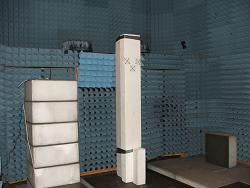RFID Interference MeasurementObjective:To develop test procedures for evaluating the impact on RFID systems of interference generated by other wireless devices. Overview:While radio frequency identification (RFID) has a broad range of applications, this project focuses on those that are relevant to homeland security, such as tracking cargo and people at U.S. borders. In particular, we are developing test procedures to evaluate the impact on RFID of interference generated by other wireless systems. Because RFID systems operate in shared frequency bands, they are susceptible to interference generated by other wireless systems. Of interest is to what degree are RFID systems affected by such interference, and how should they be tested for these effects. RFID Technologies:A variety of RFID technologies are available differing in the frequencies at which they operate and the type of tag which is queried. These characteristics, in turn, affect power requirements, read range, and suitability for various environments. Most systems operate at one of the following frequencies: 125 kHz (LF), 13.56 MHz (HF), 900 MHz (UHF), or 2.4 GHz. Active tags contain a power source (e.g., battery) and permit higher read ranges and/or lower reader power. Passive tags, on the other hand, draw power from the incident electromagnetic waves of the reader and, hence, are lower in cost. The initial phase of this project addresses 900 MHz UHF RFID systems with passive tags. Technical Approach:Wireless applications that operate license-free in the 900 MHz industrial, scientific and medical (ISM) band include supervisory control and data acquisition (SCADA), industrial automation, building automation and control, wireless sensor networks, and consumer devices (e.g., cordless telephones, wireless speakers, baby monitors). In the U.S., most such systems utilize frequency hopping spread spectrum over 902-928 MHz. To assess the impact of wireless device transmissions on RFID performance, we utilize a configurable frequency hopping source that generates an FSK-modulated signal in the 902-928 MHz band and serves as a generalized interference source. The interferer is positioned at a given distance from an RFID reader interrogating a passive tag. Tag reading success rate and throughput are measured while the interferer is emitting with various interferer transmission power levels, interferer-reader topologies, frequency hopping characteristics, and antenna polarization. The resulting test procedures and measurement analysis can be used to develop usage guidelines for passive UHF RFID systems in the presence of co-channel wireless devices.
Accomplishments:
|
Start Date:December 1, 2008 End Date:ongoing Lead Organizational Unit:ITL Source of Extramural Funding:Department of Homeland Security, Science & Technology Directorate, Test & Evaluation and Standards Division Related Programs and Projects:Contact
General Information: 100 Bureau Drive, M/S 8920 |


